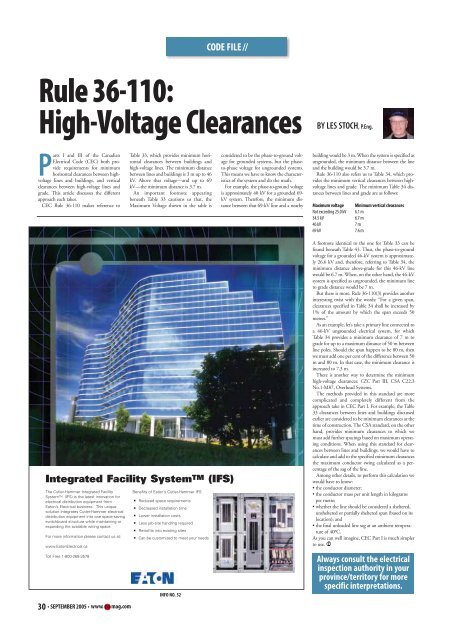September 2005.pdf - Electrical Business Magazine
September 2005.pdf - Electrical Business Magazine
September 2005.pdf - Electrical Business Magazine
Create successful ePaper yourself
Turn your PDF publications into a flip-book with our unique Google optimized e-Paper software.
CODE FILE //<br />
Rule 36-110:<br />
High-Voltage Clearances<br />
BY LES STOCH, P.Eng.<br />
Parts I and III of the Canadian<br />
<strong>Electrical</strong> Code (CEC) both provide<br />
requirements for minimum<br />
horizontal clearances between highvoltage<br />
lines and buildings, and vertical<br />
clearances between high-voltage lines and<br />
grade. This article discusses the different<br />
approach each takes.<br />
CEC Rule 36-110 makes reference to<br />
Table 33, which provides minimum horizontal<br />
clearances between buildings and<br />
high-voltage lines. The minimum distance<br />
between lines and buildings is 3 m up to 46<br />
kV. Above that voltage—and up to 69<br />
kV—the minimum distance is 3.7 m.<br />
An important footnote appearing<br />
beneath Table 33 cautions us that, the<br />
Maximum Voltage shown in the table is<br />
considered to be the phase-to-ground voltage<br />
for grounded systems, but the phaseto-phase<br />
voltage for ungrounded systems.<br />
This means we have to know the characteristics<br />
of the system and do the math.<br />
For example, the phase-to-ground voltage<br />
is approximately 40 kV for a grounded 69-<br />
kV system. Therefore, the minimum distance<br />
between that 69-kV line and a nearby<br />
building would be 3 m. When the system is specified as<br />
ungrounded, the minimum distance between the line<br />
and the building would be 3.7 m.<br />
Rule 36-110 also refers us to Table 34, which provides<br />
the minimum vertical clearances between highvoltage<br />
lines and grade. The minimum Table 34 distances<br />
between lines and grade are as follows:<br />
Maximum voltage Minimum vertical clearances<br />
Not exceeding 25.0 kV 6.1 m<br />
34.5 kV 6.7 m<br />
46 kV 7 m<br />
69 kV 7.6 m<br />
Integrated Facility System TM (IFS)<br />
The Cutler-Hammer Integrated Facility<br />
System TM (IFS) is the latest innovation for<br />
electrical distribution equipment from<br />
Eaton’s <strong>Electrical</strong> business. This unique<br />
solution integrates Cutler-Hammer electrical<br />
distribution equipment into one space-saving<br />
switchboard structure while maintaining or<br />
expanding the available wiring space.<br />
For more information please contact us at:<br />
www.Eaton<strong>Electrical</strong>.ca<br />
Toll Free 1-800-268-3578<br />
Benefits of Eaton’s Cutler-Hammer IFS:<br />
Reduced space requirements<br />
Decreased installation time<br />
Lower installation costs<br />
Less job-site handling required<br />
Retrofits into existing sites<br />
Can be customized to meet your needs<br />
INFO NO. 52<br />
A footnote identical to the one for Table 33 can be<br />
found beneath Table 43. Thus, the phase-to-ground<br />
voltage for a grounded 46-kV system is approximately<br />
26.6 kV and, therefore, referring to Table 34, the<br />
minimum distance above-grade for this 46-kV line<br />
would be 6.7 m. When, on the other hand, the 46-kV<br />
system is specified as ungrounded, the minimum line<br />
to grade distance would be 7 m.<br />
But there is more. Rule 36-110(3) provides another<br />
interesting twist with the words: “For a given span,<br />
clearances specified in Table 34 shall be increased by<br />
1% of the amount by which the span exceeds 50<br />
metres.”<br />
As an example, let’s take a primary line connected to<br />
a 46-kV ungrounded electrical system, for which<br />
Table 34 provides a minimum clearance of 7 m to<br />
grade for up to a maximum distance of 50 m between<br />
line poles. Should the span happen to be 80 m, then<br />
we must add one per cent of the difference between 50<br />
m and 80 m. In that case, the minimum clearance is<br />
increased to 7.3 m.<br />
There is another way to determine the minimum<br />
high-voltage clearances: CEC Part III, CSA C22.3<br />
No.1-M87, Overhead Systems.<br />
The methods provided in this standard are more<br />
complicated and completely different from the<br />
approach take in CEC Part I. For example, the Table<br />
33 clearances between lines and buildings discussed<br />
earlier are considered to be minimum clearances at the<br />
time of construction. The CSA standard, on the other<br />
hand, provides minimum clearances to which we<br />
must add further spacings based on maximum operating<br />
conditions. When using this standard for clearances<br />
between lines and buildings, we would have to<br />
calculate and add to the specified minimum clearances<br />
the maximum conductor swing calculated as a percentage<br />
of the sag of the line.<br />
Among other details, to perform this calculation we<br />
would have to know:<br />
• the conductor diameter;<br />
• the conductor mass per unit length in kilograms<br />
per metre;<br />
• whether the line should be considered a sheltered,<br />
unsheltered or partially sheltered span (based on its<br />
location); and<br />
• the final unloaded line sag at an ambient temperature<br />
of 40°C.<br />
As you can well imagine, CEC Part I is much simpler<br />
to use.<br />
Always consult the electrical<br />
inspection authority in your<br />
province/territory for more<br />
specific interpretations.<br />
30 • SEPTEMBER 2005 • www.<br />
mag.com

















